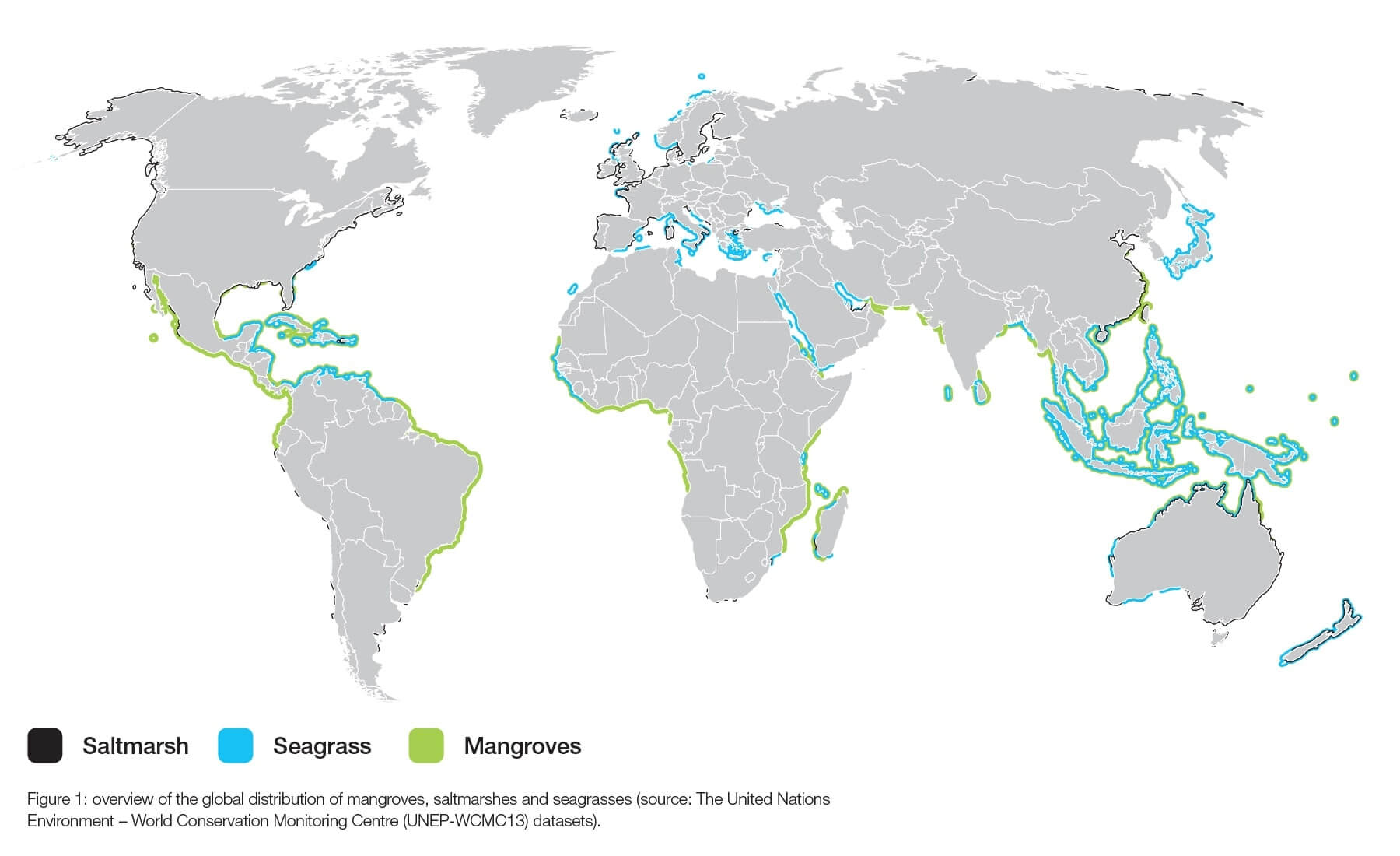WHAT IS BLUE CARBON
The term ‘coastal blue carbon ecosystems’ refers to three main types of vegetated coastal habitats – mangroves, tidal marshes and seagrasses. These ecosystems are important for addressing climate change and securing social, economic and environmental outcomes. Coastal blue carbon ecosystems can sequester two to four times more carbon than terrestrial forests (Murray et al, Nicolas Institute, 2011).
Improved management of these ecosystems can enhance food security, secure livelihoods, increase resilience, and contribute to delivering Nationally Determined Contributions to the Paris Agreement on Climate Change through carbon sequestration.
When degraded or lost, coastal blue carbon ecosystems can become significant emission sources. Mangrove deforestation is estimated to be responsible for as much as 10 per cent of emissions from deforestation globally (Donato et al, Nature Geoscience 2011).
1
MANGROVES
Mangroves are evergreen shrub lands or forests that occur in tropical and subtropical shores and estuaries. They generally grow from mean sea level to the highest spring tide. Countries with the largest areas of mangroves include Australia, Bangladesh, Brazil, Cuba, India, Indonesia, Malaysia, Mexico, Mozambique, Myanmar, Nigeria and Papua New Guinea.
2
TIDAL MARSHES
Tidal marshes are dominated by dense salt-tolerant plants such as succulent herbs and low shrubs, and grasses. They are found on soft sediments on sheltered coastlines, from the sub-arctic to the tropics, though most extensively in the temperate zones of Europe, North America, and Australia and in the higher latitudes of South-America and Africa.
3
SEAGRASSES
Seagrasses are communities of underwater-flowering plants. They are generally restricted to habitats with sediments comprised of sand, silt and mud and high light availability. Seagrasses prefer wave sheltered conditions and are found in coastal waters of all continents except Antarctica.
Photo courtesy of the Korea Marine Environment Management Corporation.
GLOBAL HABITATS
The total global area of mangroves has been estimated as 8.2 million hectares (Hamilton and Casey, Global Ecology and Biogeography, 2016). Tidal salt marshes have been conservatively estimated to cover an area of 5.495 million hectares (Mcowen et al, Biodiversity Data Journal, 2017). The global area of seagrasses is less well defined. Rates of change of mangrove ecosystems have been assessed more frequently than tidal marshes and seagrasses. Further information concerning rates of change in these ecosystems will support refined carbon estimations for inclusion in national greenhouse gas inventories and inform future projects.
CLICK MAP TO VIEW LARGER
POLICY
Policy that is protecting blue carbon
Frameworks for reporting on international climate change commitments under the Paris Agreement established by the UNFCCC together with technical guidance from the Intergovernmental Panel on Climate Change (IPCC) on national greenhouse gas accounting, provide a structure against which countries can establish national blue carbon policies. However, gaps in science and data, missing technical capacity for measurement, reporting and verification (MRV), or complex institutional arrangements can present barriers for countries developing national policies. The Partnership provides engagement opportunities for Partners to collaborate on identifying gaps, developing strategies to overcome barriers, and sharing tools and guidance for developing and implementing blue carbon protection policies, regulations, management plans or projects.
Government commitments under the Paris Agreement and through Nationally Determined Contributions (NDCs) are a key driver for countries to develop and implement national climate change policies for greenhouse gas mitigation and adaptation. However, Partners also interact with other global conventions and related initiatives such as the Ramsar Convention on Wetlands, the Convention on Biological Diversity (CBD) and the 2030 Agenda for Sustainable Development and its Sustainable Development Goals which have long recognised coastal ecosystems as critical to biodiversity and livelihoods. Similarly, Partners are engaging in global oceans policy as related to the blue economy, fisheries, reef health and anthropogenic impacts on oceans, and are leading conversations on nature-based solutions. Raising awareness of coastal blue carbon ecosystems among these forums, strengthens the case for protection and can lead to international commitments by country governments.
